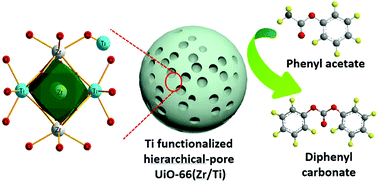Ti functionalized hierarchical-pore UiO-66(Zr/Ti) catalyst for the transesterification of phenyl acetate and dimethyl carbonate†
Abstract
Titanates are frequently used as precursors to prepare transesterification catalysts with TiIV species. Unfortunately, it is challenging to control the dispersity of TiIV active sites on supports. Herein, a series of TiIV species is anchored on abundant linker vacancy sites by introducing point and large scale defects in UiO-66(Zr/Ti) with hierarchical-pore structure. The catalyst functionalized by titanium(IV) oxide bis(2,4-pentanedionate) shows excellent catalytic performance in the transesterification of dimethyl carbonate with phenyl acetate. The catalysts are characterized by XRD, FT-IR, N2 adsorption–desorption, XPS, SEM and STEM-HAADF techniques. The results demonstrate that the delicate mesopores in the support can not only exhibit a large surface area for the distribution of the active sites, but also provide better mass transfer performance. Meanwhile, the introduction of octahedral TiIV ions raises the activity of the catalyst via more coordinatively unsaturated ZrIV sites. Furthermore, using titanium(IV) oxide bis(2,4-pentanedionate) as a Ti source can effectively prevent the condensation of tetrahedral TiIV species anchored on the hierarchical-pore UiO-66(Zr/Ti) support.



 Please wait while we load your content...
Please wait while we load your content...